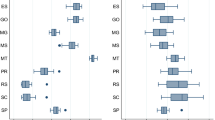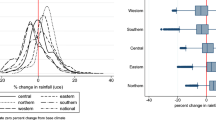Abstract
The article analyzes the impact of global climate change on the productivity of domestic agriculture and on the prospects for its long-term development. The conclusion about the moderately negative contribution of the climatic factor to the forecast dynamics of agricultural production and exports is substantiated.

Similar content being viewed by others
Notes
That is, the sum of the average daily air temperatures is above +10°C (per year).
The RCP 4.5 scenario assumes a reduction in global greenhouse gas emissions after 2040 and a warming to 2°C in 2046–2065 (compared with the level of 1986–2005), and the RCP 8.5 scenario, an increase in greenhouse gas emissions up to 2100 and a warming to 2.6°C in 2046–2065.
The methodology and key results of our calculations are presented in [12]. The scenario of inertial growth in grain production should be considered as very optimistic and ambitious – it can be realized in the conditions of a high conjuncture of foreign markets, large-scale expansion of export infrastructure and state support for grain transportation from regions remote from export terminals. Otherwise, the rate of increase in the level of intensification and production volumes will be lower.
To move from the basic to the adjusted scenario, the previously obtained forecast estimates of the yield of grain crops in various macroregions was changed for the average yield of 2013–2017, multiplied by the relative increase in yield in the RCP 8.5 scenario (see Table 1).
The reserves of the intervention fund decreased by 8.2 million tons – from 9.6 million tons on July 1, 2010 to 1.4 million tons on July 1, 2013.
With the expansion of irrigated areas, crop yields in arid territories may exceed projected values in the basic scenario.
According to FAO estimates, for the period of 2011–2050, climate-related yield growth in Canada may be 27%, in the EU countries 16%, in Mexico 8%, in Russia 4%, while in African countries there will be a decrease in productivity by 12%, in South Asia and India by 5% [14, p. 22].
According to Rosstat [11], the number of cattle decreased from 27.5 million units in 2000 to 18.2 million units in 2018, and the number of cows from 12.7 million units to 7.9 million units. The main factor in reducing the number of livestock was the increase in annual milk yield per cow (from 2.5 thousand kg/year to 4.5 thousand kg/year) at stagnation of domestic milk production.
They can be repressive (“carbon tax”) or supportive (subsidizing capital and operating costs of agricultural producers to the transition to resource-saving technologies).
Additional restrictions may be imposed by external consumers due to the admission to their markets of only “environmentally friendly” agricultural products produced using resource-saving technologies. At the same time, Russian exports are so far focused on deliveries to “poor” countries, for which the main criterion is the price of the product, and not the volume of greenhouse gas emissions from its production.
REFERENCES
V. M. Kattsov, N. V. Kobysheva, V. P. Meleshko, et al., Assessment of Macroeconomic Effects of Climate Change in the Russian Federation for the Period up to 2030 and the Future Perspective, Ed. by V. M. Kattsov and B. N. Porfir’ev (D’Art, Moscow, 2011) [in Russian].
Report on Climate Risks in the Russian Federation (Climatic Center of Roshydromet, St. Petersburg, 2017) [in Russian]. https://cc.voeikovmgo.ru/images/dokumenty/2017/riski.pdf.
O. D. Sidorenko and V. N. Pavlova, Methods for Assessing the Effects of Climate Change on Physical and Biological Systems (Roshydromet, Moscow, 2012), Ch. 5. http://downloads.igce.ru/publications/metodi_ocenki/05.pdf.
V. N. Pavlova, “Agroclimatic resources and agricultural productivity in the implementation of new climate scenarios in the 21st century,” Tr. Glavn. Geofiz. Obs. im. A. I. Voeikova, No. 569, 20–37 (2013).
"Weather gets nervous. How global climate change affects agriculture," Agroinvestor (2019). https://www. agroinvestor.ru/analytics/article/32343-pogoda-stanovitsya-nervnoy/.
The Second Assessment Report of Roshydromet on Climate Change and Its Effects on the Territory of the Russian Federation (Federal Service for Hydrometeorology and Environmental Monitoring (Roshydromet), 2014). https://cc.voeikovmgo.ru/images/dokumenty/2016/od2/ od2full.pdf.
A. V. Gordeev, A. D. Kleshchenko, B. A. Chernyakov, et al., Bioclimatic Potential of Russia: Adaptation Measures in Changing Climate, Ed. by A. V. Gordeev (Minsel’khoz. Ross. Fed., Moscow, 2008) [in Russian].
M. Yu. Ksenofontov, D. A. Polzikov, Ya. S. Mel’nikova, and Yu. S. Verbitskii, “Major trends and factors of the spatial development of Russia’s agro-industrial complex in retrospect (on the example of meat, milk, and grain markets),” in Scientific Proceedings:Institute of Economic Forecasting, Russian Academy of Sciences (2019), pp. 143–173 [in Russian].
M. Yu. Ksenofontov, D. A. Polzikov, and A. V. Urus, “Food security and grain market regulation in Russia,” Stud. Russ. Econ. Dev. 30, 606–613 (2019).
Agricultural Market Review (Deloitte Research Center in the CIS, 2017). https://www2.deloitte.com/content/dam/Deloitte/ru/Documents/consumer-business/russian/snapshot-of-the-russian-2017-agroindustry-rus.pdf.
Database of Official Statistics EMISS. https://fedstat.ru/.
Agricultural Market Overview (Deloitte Research Center in the CIS, 2019).
The Long-Term Strategy for the Development of the Grain Complex of the Russian Federation until 2035. The Order of the Government of the Russian Federation (2019). http://static.government.ru/media/files/y1IpA0ZfzdMCfATNBKGff1cXEQ142yAx.pdf.
The State of Agricultural Commodity Markets: Agricultural Trade, Climate Change and Food Security (Food and Agriculture Organization of the United Nations, Rome, 2018). http://www.fao.org/3/I9542EN/i9542en.pdf.
IPCC, 2014:Climate Change 2014: Impacts, Adaptation, and Vulnerability. Part A: Global and Sectoral Aspects. Contribution of Working Group II to the Fifth Assessment Report of the Intergovernmental Panel on Climate Change,Cambridge University Press (Cambridge–New York, 2014).
Author information
Authors and Affiliations
Corresponding author
Additional information
Translated by S. Avodkova
Rights and permissions
About this article
Cite this article
Ksenofontov, M.Y., Polzikov, D.A. On the Issue of the Impact of Climate Change on the Development of Russian Agriculture in the Long Term. Stud. Russ. Econ. Dev. 31, 304–311 (2020). https://doi.org/10.1134/S1075700720030089
Received:
Revised:
Accepted:
Published:
Issue Date:
DOI: https://doi.org/10.1134/S1075700720030089




